#E-learning online ads
Explore tagged Tumblr posts
Text
What Is an Educational Campaign?
In the rapidly evolving landscape of online education, businesses and institutions alike are turning to educational campaigns to effectively market their services and reach target audiences. These campaigns can take many forms, such as online advertisements, email marketing, social media strategies, and more. Understanding the intricacies of an educational campaign is key to boosting visibility, engagement, and ultimately, conversions. This comprehensive guide will take you through every aspect of educational campaigns and how you can leverage them for success in the E-Learning industry.

#promoting elearning#advertise e-learning#online learning ads#e-learning online ads#promote e-learning#e-learning ppc agency#ads e-learning#ads for education#online course ads#market online course
0 notes
Text
Promote Online Courses | Online Learning Ads | E-learning Campaigns
In today's digital age, the demand for online courses has surged exponentially. As more individuals seek convenient and accessible ways to learn, the importance of effectively promoting online courses cannot be overstated. Imagine having a wealth of knowledge to share, but no audience to receive it. That's where the power of advertising in e-learning comes into play.

For more information click on-https://www.7searchppc.com/e-learning-ads-network
#E-learning ad campaigns#Ad network#E-learning Marketing#Advertise Online Courses#Online learning ads#Elearning PPC services#Promote E-learning#E-learning CPC#E-Learning advertising#E-Learning marketing#Best E-Learning Marketing Campaigns#Best E-Learning ad platform#E-Learning Ads Network#E-Learning advertising examples#creative E-Learning advertisement#Online E-Learning advertisement#PPC Advertising for E-Learning#Pay-Per-Click Advertising for E-Learning#E-Learning PPC Agency#E-Learning ads#Advertise E-learning#E-learning online ads#ads E-Learning#Best E-Learning Ad Networks#Best E-Learning Native Advertising Platforms#online learning ads#elearningmarket
0 notes
Text
dark themes and content in a piece of media are a natural expression of the human condition, and even the nastiest stories have their place, and the appropriateness can be judged based on intent, impact, etc.– this all said, I still think it's fucking hilarious how batshit tumblr discourse went over killing stalking bc its explicitly a horror story and the title is like a walking "dead dove don't open". like. i can't believe there's blood in my texas chainsaw massacre movie.
#killing stalking#have i read it? no#i heard about it#learned some of the premise and decided it wasn't for me#but like it's not really a secret that it's going to be a fucked up story#honestly i think it only got as weirdly controversial as it did bc it started#around the same time yoi was finishing#and some people were like oh hey this is two men#despite. the overwhelming differences#n e way#but like yeah no one was tricked into reading it by a predatory ad or something this was an Online Comic that just sort of#snapped in to the public conciousness
9 notes
·
View notes
Text
no i don't want a popup to tell me what the traffic is like (i don't want to know why you know where i work. also, if i wanted to know i would look it up).
no i don't want headlines in my start menu or my search bar (if i wanted to know i would look it up).
no i don't want to know the sports game score (if i wanted to know i would look it up).
no i don't want to know the stock numbers (if i wanted to know i would look it up).
no i don't want weather notifications (if i wanted to know i would look it up).
i also really don't want to see ads and sponsored content in the weather app, which i only opened so i could disable notifications (are you serious right now?)
no i don't want auto generated icons in my search bar representing those headlines and current events i, once again, did not want to see in my search bar.
i don't want to sync my files to the cloud. no, really, please stop asking. (i tried it once. it shredded my project files). no i don't want to see ads for onedrive in my file explorer. or in my taskbar.
no i don't want to see ads for copilot in my taskbar (siri, alexa, & cortana can also leave me alone forever please and thank you).
no i don't want you to swap my wallpaper without asking me to some spotlight service as a ploy to show me more ads i didn't want to see, weather i didn't ask for, and has nothing to do with the wallpaper i already set up.
#leave me alone leave me alone leave me alone leave e ALONE#i am so fucking serious#the in-between places in a computer used to be white space#it's bad enough you can't go anywhere or do anything online without running into ads or having your data sold or#just stuff. everywhere. it's overstimulating as all hell. do you get me??#i can't even play a video game without hitting a dozen ads first anymore because the MENU of my XBOX is full of ads#we live in a hellscape#vent post#negativity#anti windows#anti capitalism#seriously considering swapping to linux#i don't know a thing about it but maybe it's time to learn
1 note
·
View note
Text
E-Learning Online-Werbung (Google Ads, Facebook Ads) erstellen – Agentur für digitale Schulung & Online Kurs Anbieter
Erfahren Sie, wie Sie effektive E-Learning Online-Werbung mit Google Ads und Facebook Ads erstellen. Unsere Agentur bietet digitale Schulungen und Online Kurse für Ihren Erfolg. Einführung in die Erstellung von E-Learning Online-Werbung In der heutigen digitalen Welt ist die effektive Nutzung von Online-Werbung unerlässlich, um Ihre E-Learning-Angebote erfolgreich zu vermarkten. Ob Sie eine…
#Berufliche Weiterbildung#Betriebliche Weiterbildung#Corporate Learning#E-Learning#Facebook Ads)#Online Kurse#Online-Werbung (Google Ads#Schulung#Training#Weiterbildung
0 notes
Text
Mastering LinkedIn Ads in 2024: Proven Methods for Success
As we navigate through 2024, LinkedIn remains an indispensable platform for businesses aiming to connect with professionals and decision-makers worldwide. Mastering LinkedIn Ads this year requires a strategic approach, leveraging proven methods to maximize engagement and ROI. Here’s how you can achieve success with Mastering LinkedIn Ads in 2024:
Understanding the Impact of LinkedIn Ads
LinkedIn Ads offer unique advantages tailored for B2B marketing:
Targeting Precision: Reach your ideal audience based on job title, industry, company size, and seniority, ensuring your ads are highly relevant.

Engagement: Professionals actively engage with industry-related content on LinkedIn, making it a prime platform for B2B interactions.
Brand Building: Establish authority and credibility within your industry by delivering valuable content directly to professionals.
Proven Methods for LinkedIn Ads Mastery in 2024
To excel with LinkedIn Ads this year, implement these proven methods:
Clear Objective Setting: Define clear goals for your LinkedIn Ads campaigns, whether it’s lead generation, brand awareness, or driving website traffic.
Audience Segmentation: Utilize LinkedIn’s robust targeting options to segment your audience effectively. Tailor your messaging to resonate with different segments.
Compelling Ad Creative: Craft engaging ad creatives that capture attention and communicate your unique value proposition clearly and succinctly.
Conversion Optimization: Use LinkedIn’s conversion tracking tools to measure and optimize campaign performance. Test different ad formats and messaging to optimize for conversions.
Continuous Improvement: Regularly analyze campaign metrics and adjust your strategy based on insights. Stay updated with LinkedIn’s latest features and best practices.
Leveraging LinkedIn Ads Mastery Courses
Investing in a LinkedIn Ads mastery course specific to 2024 can provide you with structured learning and practical insights. Look for courses that cover:
Advanced Targeting Strategies: Learn how to leverage LinkedIn’s advanced targeting features to reach decision-makers effectively.
Creative Optimization: Understand best practices for creating compelling ad content that drives engagement and conversions.
Analytics and Reporting: Master the use of analytics tools to measure campaign success and make data-driven decisions.
Embracing Online E-Learning Platforms
Online e-learning platforms offer convenient access to LinkedIn Ads mastery courses, allowing you to learn at your own pace and from anywhere in the world. Benefits include:
Flexibility: Fit learning around your schedule, accessing resources when it’s most convenient for you.
Expert Guidance: Benefit from insights shared by industry experts who understand the nuances of LinkedIn advertising.
Certification: Some courses offer certifications upon completion, enhancing your credentials as a LinkedIn Ads specialist.
Conclusion
Mastering LinkedIn Ads in 2024 requires a blend of strategic thinking, creativity, and a deep understanding of your target audience. By adopting proven methods and staying informed through LinkedIn Ads mastery courses and online e-learning platforms, you can elevate your marketing efforts and achieve tangible business results.
Start implementing these strategies today to harness the full potential of LinkedIn Ads and propel your business towards success in 2024 and beyond.
0 notes
Text
https://www.dotit.io/post/shopify-development-costs-in-the-usa
#artificial intelligence#branding#digital marketing#google ads#linux#machine learning#marketing#online marketing#programming#python#shopify#e commerce#online store#sales#wordpress development#web development#software development#game development#mobile app development#self development#design#webdesign#web design#website#website development#website design#website seo#website optimization#website traffic#php
1 note
·
View note
Text
There is no such thing as AI.
How to help the non technical and less online people in your life navigate the latest techbro grift.
I've seen other people say stuff to this effect but it's worth reiterating. Today in class, my professor was talking about a news article where a celebrity's likeness was used in an ai image without their permission. Then she mentioned a guest lecture about how AI is going to help finance professionals. Then I pointed out, those two things aren't really related.
The term AI is being used to obfuscate details about multiple semi-related technologies.
Traditionally in sci-fi, AI means artificial general intelligence like Data from star trek, or the terminator. This, I shouldn't need to say, doesn't exist. Techbros use the term AI to trick investors into funding their projects. It's largely a grift.
What is the term AI being used to obfuscate?
If you want to help the less online and less tech literate people in your life navigate the hype around AI, the best way to do it is to encourage them to change their language around AI topics.
By calling these technologies what they really are, and encouraging the people around us to know the real names, we can help lift the veil, kill the hype, and keep people safe from scams. Here are some starting points, which I am just pulling from Wikipedia. I'd highly encourage you to do your own research.
Machine learning (ML): is an umbrella term for solving problems for which development of algorithms by human programmers would be cost-prohibitive, and instead the problems are solved by helping machines "discover" their "own" algorithms, without needing to be explicitly told what to do by any human-developed algorithms. (This is the basis of most technologically people call AI)
Language model: (LM or LLM) is a probabilistic model of a natural language that can generate probabilities of a series of words, based on text corpora in one or multiple languages it was trained on. (This would be your ChatGPT.)
Generative adversarial network (GAN): is a class of machine learning framework and a prominent framework for approaching generative AI. In a GAN, two neural networks contest with each other in the form of a zero-sum game, where one agent's gain is another agent's loss. (This is the source of some AI images and deepfakes.)
Diffusion Models: Models that generate the probability distribution of a given dataset. In image generation, a neural network is trained to denoise images with added gaussian noise by learning to remove the noise. After the training is complete, it can then be used for image generation by starting with a random noise image and denoise that. (This is the more common technology behind AI images, including Dall-E and Stable Diffusion. I added this one to the post after as it was brought to my attention it is now more common than GANs.)
I know these terms are more technical, but they are also more accurate, and they can easily be explained in a way non-technical people can understand. The grifters are using language to give this technology its power, so we can use language to take it's power away and let people see it for what it really is.
12K notes
·
View notes
Text

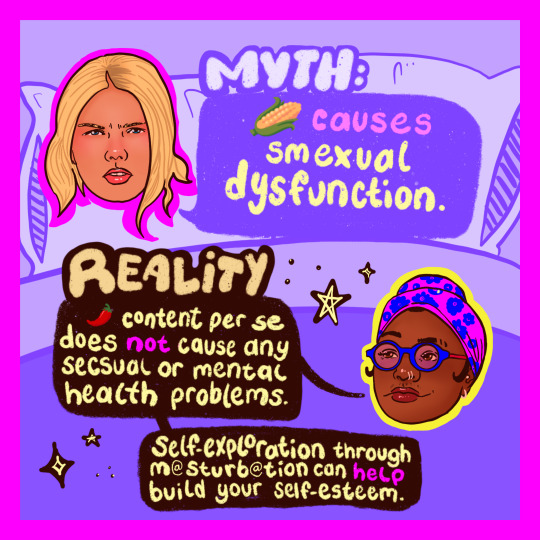
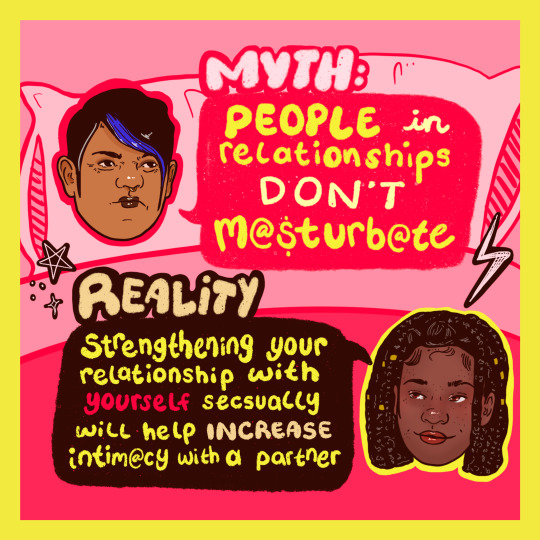



❤️ Most of us never receive comprehensive smex education. Instead, if you’re like me, you learned from the internet… but most of the 🌶️ content we find online is created only for the male gaze. It’s time to remove the shame around self-pl3sure and separate fact from fiction.
❤️ @getcheex and I teamed up to bust some common myths around m@sturb@tion! Any of ‘em surprise you?
❤️ Platforms like CHEEX (my personal fav) are redefining the industry and creating safe spaces with spicy content that is ethically produced alongside resources. @getcheex is safe, aesthetically pleasing and even features educational resources on the topic of $ecsual wellness (and more!)
❤️ Try CHEEX for yourself - go to the link in my bio 🔗or to g e t c h e e x . c o m and use my code LIBERALJANE to get 7 days of unlimited access to the whole platform*!
#GetCHEEX #Ad
*the code applies when you select the yearly subscription option as a new customer. You can cancel anytime or switch to the monthly plan anytime during the 7 days.
#art#feminism#self pleasure#feminist art#cheex#ad#paid partnership#sex education#sex ed for grownups#sex educator
184 notes
·
View notes
Text
what i feel like each of the 9 would get canceled for if they were online niche celebs
percy: probably for saying his hands are rated E for everyone including women and children but everyone wld accuse him of DV and it’d upset him so much he’d pull a jenna marbles and disappear off the face of the internet making him forever the one who got away
annabeth: she’d become a lolcow in a way bc ppl wld learn she’s very passionate and would purposefully @ her random incorrect things that would piss her off and make her go on long twitter rants so she’d consistently get canceled for either bulling on main or for just being a know it all
piper and rachel: for being coal miners (opposite of gold diggers) everyone would say they live in the “poor aesthetic” and ppl wouldn’t like that
jason: for being accidentally racist bc like 4 years ago his black friends told him to say a word that sounds a lot like the n word and once he found out he cried for like 4 days straight and it still haunts him every year he puts out a post abt it and apologizes for adding to the systemic racism that’s plagued the world (all of this and no one knows wtf he’s talking abt bc this incident happened at home with friends and if he never brought it up no one would know but he’s self canceled for it bc he feels that bad)
nico: for being HELLA racist on main like maybe one day he just insults someone but it isn’t an insult it’s a SLUR and everyone’s like ?? WTF once this happens once he gets a sit him down where they go through everything he can and can’t say and why
will and piper: for saying the f/d slurs and the rainbow police wld pull up and cancel them for it bc their bi and not gay/lesbian
leo: probably for reposting a meme he didn’t fully understand but thought the pic was funny until he found out it was extremely offensive
hazel and frank: probably the age gap that’s all fr
hazel: she’d actually be canceled bc she’d say smth abt gender roles and she’d also get a sit down talking abt what’s different now
reyna: for being too blunt/rude on main and everyone thought she was being mean when that’s just how she talks she doesn’t apologize so she just kinda becomes known as the mean one until they see her interact with ppl she actually likes
#pjo#hoo#percy jackson#percy jackon and the olympians#heros of olympus#hoo fandom#pjo fandom#hoo text post#pjo text post#hoo/pjo#piper mclean#will solace#rachel elizabeth dare#annabeth chase#reyna avila ramirez arellano#nico di angelo#jason grace#leo vladez#frank zhang#hazel levesque#mo talks a lot#pjo memes
65 notes
·
View notes
Note
I'm planning on publishing my written fiction online in both Portuguese (my native language) and in English (the other language I speak which might help to share the story with more people), but something is worrying me.
I watched a movie where the a main character (a writer) had a book that wasn't popular and another character "translated" into her language (what she actually did was rewrite it as an erotic novel) and the book was super loved there (the readers didn't know the book was supposed to be different)
Sometimes I see artists who allow fans to share translations of their comics, but I'm concerned on what could happen if someone asked for permission to translate. Do you think it's worth the risk of someone making my story popular with something that goes against my values, like supporting disregard to a human right or making it erotic when it was supposed to be family-friendly?
Worried About Fan Translations
I want to be clear that this advice is specific to fiction published online versus e-books or print books, which are a different matter entirely. First and foremost, if you post a story online, give permission to a fan to translate it, and then they rewrite it into something else, that is plagiarism and a copyright violation, and you have every right to ask them to take it down. If they refuse to cooperate, you can threaten them with a lawsuit, even if you don't really have the means to follow through. That could be enough to get them to take it down. If not you can report them to the platform for stealing your work. You can also let your fans know that this person has stolen your work and to please block them or refuse to engage with them.
If you post a story online and are approached by a fan who asks to translate it into their native language, there are some things you can do to potentially protect yourself:
1 - Do not give them permission to post the translation on their own account. Thank them for their offer and let them know you're happy to let them translate the story, but they will need to e-mail it to you so you can have it vetted and post it on your own account with credit. Be clear that you do not give them permission to post a translation on their own account. That way, not only does it dissuade people who are only interested in plagiarism or benefiting off your hard work, it also means you keep full control of your story and its translations.
2 - Do your best to vet the translation. You can try to find a beta reader who is fluent in that language who can read it and make sure it's a good translation, though you'll likely have to pay them, which is worth it to make sure the translation is accurate. Or you could copy chunks of the story into Google Translate, which isn't a great translation service, but at least you'll see right away if the person has added erotica or written anything that's drastically different.
3 - Do your best to vet the translator. Another thing you can do is try to vet the translator. Ask them if they've ever translated a story before, and if so, ask them for examples. Look at their account and see if they have posted other translations or have posted links to translations. Investigate the authors of the stories they translated and see if there are any complaints. Read through the comments of the original story and the translation (you may again have to use Google Translate if it's a language you're not familiar with... not perfect, but just fine for this application...) are similar. If a lot of comments on the translation mention elements that aren't mentioned in the source story comments, that's a potential red flag.
I hope that helps!
•••••••••••••••••••••••••••••••••
I’ve been writing seriously for over 30 years and love to share what I’ve learned. Have a writing question? My inbox is always open!
♦ Questions that violate my ask policies will be deleted! ♦ Please see my master list of top posts before asking ♦ Learn more about WQA here
40 notes
·
View notes
Text
BuildTech

Emily, a determined and hardworking college student, found herself in a constant struggle to make ends meet. With mounting bills and the pressure of rent looming over her, she embarked on a relentless job search to secure a source of income.
One day, as she scrolled through countless job listings online, a particular advertisement caught her attention. It read, "Exciting Opportunity at BuildTech: Join our Dynamic Team!" Intrigued by the promise of excitement, Emily clicked on the ad to learn more.
The BuildTech website showcased a vibrant and innovative company, known for its groundbreaking projects and commitment to excellence. As Emily delved deeper into the company's mission and values, she couldn't help but feel drawn towards the company and this empty position. Emily decided to take a chance and submit her application. She carefully crafted her cover letter and updated her resume to highlight her skills like her leadership or strong mind and determination. With a glimmer of hope, she pressed the "Submit" button, eagerly anticipating a response.
Days turned into weeks, and Emily's anticipation grew with each passing moment. Doubts and worries began to creep into her mind, questioning whether she was qualified or if she would ever find a job that could alleviate her financial burdens.
Just as she was starting to lose hope, an email notification appeared in her inbox. Her heart raced as she clicked on the message, revealing an invitation for an interview at BuildTech. The excitement and relief she felt were palpable.
Emily meticulously prepared for the interview, researching the company's projects and familiarizing herself with the construction industry. Dressed in her best professional attire, she arrived at the impressive office building that housed BuildTech, her determination unwavering.
As she stepped into the sleek and modern reception area, the ambiance exuded an air of professionalism and ambition. The receptionist, Sarah, greeted her warmly and directed her to the interview room. Emily couldn't help but feel a sense of anticipation and nervous energy as she entered the room.
Sitting across from Mike, the manager of BuildTech, Emily was immediately struck by his friendly demeanor and genuine interest in her. The interview commenced, with Mike delving into her background, skills, and aspirations. He sought to understand her motivations and determine if she would be a good fit for the company's dynamic team.
Throughout the interview, Emily's passion and dedication shone through. She expressed her desire to contribute to meaningful projects and make a difference in the world. Mike, impressed by her enthusiasm and genuine nature, saw great potential in her.
As the interview came to a close, Mike leaned forward with a smile on his face. He extended his hand and offered Emily the position at BuildTech, citing her determination and alignment with the company's values. Emily's heart swelled with gratitude and excitement. Finally, a breakthrough had come her way.
If she only knew that the company just hired men…
Ecstatic about her new job at BuildTech, Emily eagerly awaited her first day of work.
The day arrived, and Emily arrived at the BuildTech headquarters with a mix of nerves and anticipation. She was greeted by Sarah, the friendly receptionist she had met during her interview. Sarah handed her a set of documents to fill out and explained the basics of the company's policies and procedures. Emily, so caught up in small talk, didn't even realize she signed the documents confirming her work profile to be updated as male and her work position being a construction worker not a second assistant.
After completing the paperwork, Sarah led Emily down a long corridor towards the employee facilities. As they walked, Emily couldn't help but notice that everyone she passed in the corridor was male. It seemed odd to her, but she brushed it off, assuming it was just a coincidence.
Sarah stopped in front of a door labeled "Employee Dressing Room." She explained that Emily would find her uniform inside and instructed her to change into it before joining the rest of the team on the construction site. Emily thought to herself “wait wasn't my position second assistant, why do i need a construction uniform.” but she brushed it off again as a small misunderstanding. Emily stepped inside the dressing room.
To her surprise, the dressing room was unlike any she had ever seen. It was a sleek, futuristic space with walls adorned by mirrors and high-tech displays. Emily's reflection stared back at her, a mix of excitement and curiosity in her eyes.
In the center of the room, there was a platform illuminated by soft, glowing lights. A voice echoed from the speakers, its tone soothing yet authoritative. "Welcome, Emily, to BuildTech's Gender-Conforming Dressing Room. Please step onto the platform for scanning and outfit customization."
Curiosity overcoming her, Emily complied and positioned herself on the platform. As she stood there, the room's lights brightened, casting a gentle glow around her. A series of scanning beams enveloped her body, analyzing her physical features and detecting any inconsistencies.
To her shock the bright lights turned red, the AI system detected that Emily's assigned gender did not match her work profile. The robotic arms in the room sprang into action, undressing her. Emily felt a mix of confusion and vulnerability as the arms swiftly removed her clothing.

The next moment, the robotic arms approached her and grabbed her so they could correct her. they began spraying Emily in a thin clear coating, each movement molding the spray to her body. Emily felt a tingling sensation, almost as if her very essence was being reshaped.
First up was her legs as the skin-like suit adheard to her bones and molded them her calves grew pushing her from her ordinary 5’6 to a a 5’7. Her legs continued to mold and gained muscle mass on top of muscle mass and next up was her feet, her feet grew so much that she looked out of proportion, she now sported real man's feet and it continued with her thighs giving her juicy big thighs matching her now changed legs and feet. Before the transformation moved forward it blessed her legs and feet with a generous amount of hair and also gave her bad boy feet a rank stench so powerful she needed to cover them up daily. The molding continued and moved upwards the changes barely touched her bouncy butt, the spray just molded her feminine curves into the strong masculine side making her butt fuller and firmer.
The magic of the spray went on to continue and gave her torso a great gift. Her torso fat melted into string and hard abs and her female gender became male with the dick growing hard and big, to complete her downstairs or well his downstairs the changes gave him a full treasure line with hair his once female breasts flattened into some rock hard pecs adorned with yet again sweaty musky body hair.

His arms ballooned giving his once small biceps muscles. The arms extended and filled with arm hair and veins giving a strong and yet inviting look. His hands grew from a delicate soft hand into hands that could hold any dick or tool easily, these new hands were calloused and dirty from hard work and experience. Next was the armpits which grew to match the muscles and became hairy and wet sporting the same foul smell.
His physical appearance transformed before his eyes. The contours of his face shifted, becoming more angular and masculine giving him a perfect jawline and the perfect nose. His voice deepened, resonating with a newfound confidence and authority but also masculinity and toughness.
As the transformation progressed, Emily's mind underwent a parallel change. Memories of his past life as Emily faded into the background, replaced by a new sense of self. He no longer identified as Emily but embraced his new identity as Alex, a strong and capable construction worker.
The spray completed the transformation by stretching Alex from 5’7 to 5’11. The robotic arms dressed Alex in a pair of white socks or by the looks of it almost yellow, the socks had the same smell as Alex feet explaining the odor. Next the arms dressed him in sturdy work boots that were well worn and were made of sturdy leather. Alex got put in rugged pants adorned with stains and mud and some tools, Alex also got a durable work shirt with a vest. The robot arms placed a construction worker's hard hat atop his head, symbolizing his new role within the company and sealing his new identity, and with that the world only knew Alex.
Stepping out of the dressing room, Alex felt a surge of confidence coursing through his veins. The world around him seemed to shift, as if acknowledging his new identity. Colleagues who once knew Emily now saw him as Alex, a skilled and respected member of the construction team.
As he walked among his new coworkers, Alex couldn't help but notice the subtle nods of approval and respect. He had earned his place in this traditionally male-dominated industry and was now another worker in the crowd.

#hivis#workie#workies#tradie#worker#musk#chav lads#jockification#shiny gear#male tf#tf story#female to male#leather boots#hi vis workwear#my post#my writing
275 notes
·
View notes
Text





Watch me slowly learn how do properly draw these two!!!!
Ok I’ve always thought that it made no sense that Aiden was “the e-boy” but seemingly had no connection to being online?? Maybe he had a hard time online which is why he quit. MAYBE that hard time led him to becoming some kind of antagonist on the show (I’ve thought about this too much lmao). I feel like it was wasted potential that could have added to his character so I made this scene!!!
I might make more of these this was rly fun.
#illustration#artwork#digital art#digital illustration#fan art#total drama#disventure camp#art#lgbt#artists of tumblr#comic art#fan comic#james x aiden#jaiden disventure camp#aiden disventure camp#james disventure camp
115 notes
·
View notes
Text
0 notes
Text
As every major social media platform crumbles around us in their rush to enshittify faster I'd like to (selfishly) ask you to support your favorite artists and writers by signing up for their fucking newsletter.
I know it's old-fashioned. I know e-mail is not cool or fun. I know that signing up for a newsletter is a bigger lift than clicking a Follow button. I know a lot of newsletter content you will receive may not be interesting or useful or well-designed. (But not every tweet or insta story or tumblr post is gonna be, either.)
Artists and writers need your buy-in on this ESPECIALLY queer and PoC who face an even worse uphill battle on these platforms. Forget the harassment (although that part sucks too) it's almost impossible for me to actually talk to my followers on a lot of places because the stuff I post about--trans people and books about them--get hidden by that algo. Why should I waste my time making Content that even people who follow me probably won't see unless I spend money I don't have on ads? Content that btw will be sold to AI scrapers so they can "learn" from me without giving me anything in return.
My point is, online spaces are no longer serving the purpose of connecting people. They are not forever. All it takes is one shitty business decision (or a wild series of them) to turn a social media platform into a ghost town. It's frustrating to invest a lot of time and energy into these things and then POOF the following you worked so hard to amass is in the wind.
so here's my newsletter if you're interested. It's about my trans and nonbinary romance novels. I send it like once a month. I try to keep it short and sweet, just updates about my books and recs for books I liked. It's really the only solid way to keep track of me because every day I am more convinced that stepping back from social media is better for me personally and professionally.
If you truly care about supporting people doing creative things, please please please sign up for whatever individual update system they use, which is probably a newsletter.
59 notes
·
View notes
Text
a lot of people like to begin and end their research into the possibility of endogenic systems existing by merely aggressively pointing to the DSM5 definition of dissociative identity disorder and using this to make some complex claims like:
"dissociative identity disorder is only ever formed by early childhood severe trauma, and so if you don't experience disordered symptoms of plurality, you don't have dissociative identity disorder, therefore you can't be a system."
however, if you ever bothered to look more into psychological literature, as you should before making grandiose sweeping opinionated claims with insufficient research backing, you'd know that the experience of plurality is actually, within the psychiatric community, discussed heavily.
there are plenty of paradigms where you can find things analogous in description to nondisordered, therapist-endorsed plurality, including therapeutic methods of engaging with oneself as plural as a means of Improving oneself: for example, Schema Therapy (often utilized with borderline patients and people with personality disorders), and Internal Family Systems (often utilized in general types of patients, whether or not they were severely traumatized as a child or even as an adult or adolescent)
as a side note, it's very anti-intellectual to have rabidly-held opinions that you bully people online about without even bothering to do a ton of research, especially into perspectives from academics that disagree with your personal very online opinions. any serious practicioner of psychology would be one who is open-minded and seeking to not Confirm a Theory but to learn and form new ideas based on what their clients can teach them.
it's also quite offensive towards survivors of psychiatric abuse to insist upon the psychiatric system of diagnostics as the end-all-be-all of one's existence, and it smells like major bootlicking to only ever allow oneself and others to be ~valid~ If an authority confirms it. it's not like the DSMs are these perfect encapsulations of everything ever that could happen psychologically, things are added and removed all the time, and those actions often accrue significant behind-the-scenes debate in the academic sphere, where people with write papers on why they think something should or shouldn't be there. remember, the DSM is simply supposed to be a Tool that Guides clinicians in order to help them distinguish certain phenomena from others, but at the end of the day not only is it Not supposed to focus on nondisordered manifestations of behaviors, but it's also not made to reductively simplify any active debate in psychiatry merely because one thing is canonized a certain way, just so you can be Right Online™
anyway. in schema therapy, schemas are said to be parts of people that hold certain typified negative self-belief systems, and patients are encouraged to both label them and speak to or as them, in order to convince their parts of new and more healthy or productive modes of thinking, rather than getting triggered into letting the schema take over and give them negative thoughts and emotional issues.
these parts are understood within the literature to be natural to everybody, because everyone compartmentalizes into belief + emotional structures like these; what makes them 'not dissociative identity disorder' is merely the fact that these parts do not cause amnesia when taking over the core self, and that they are often identified as 'parts' of the primary person, rather than fully separated other people with distinct consciousnesses. nonetheless, this is one of many examples of the parts work methodology wherein the self is casually understood to be multiple or have subpersonalities or parts within psychological literature, and that fact is then taken towards the conclusion of using this experience in a healing-oriented way.
here is an example of schema therapy, an excerpt of A Client’s Guide to Schema Therapy by David C. Bricker, Ph.D. and Jeffrey E. Young, Ph.D. who are from the Schema Therapy Institute;
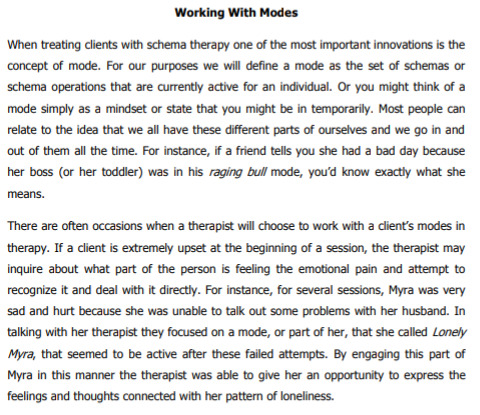
moving on, there is my other example: internal family systems. in IFS, clients are encouraged by their practitioner to personify and then actively dialogue with their various emotional states and common modes, and also to look for particular styles of parts already well-known by the IFS paradigm such as 'firefighters' and 'managers,' which are two different kinds of protector parts. with IFS becoming popularized nowadays, more and more laypeople are now becoming comfortable with the idea that they have psychological parts, which can be parts of their personal Self or parts that exist within them and hold certain emotional functions, despite perhaps not experiencing the typical heavy dissociative states definitive of disordered types of multiplicity like DID.
here are some excerpts from a book called The Others Within Us, by Robert Falconer, with a foreword by Dick Schwartz, the founder of IFS, as well as many high praise reviews from members of the psychiatric community for his writing, which breaks new grounds and is very in-depth and thorough.
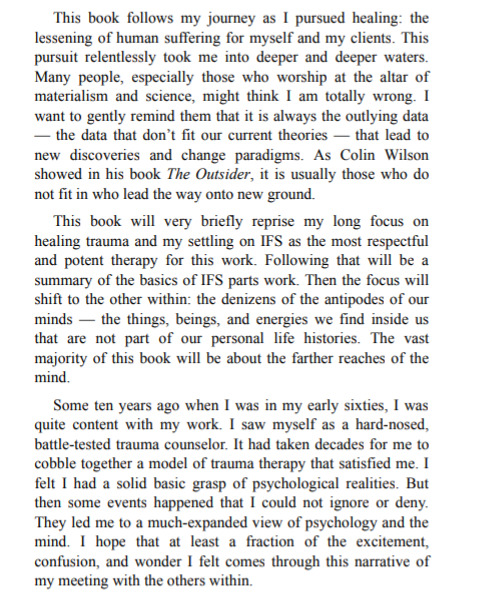
here he discusses needing to have an open mind towards phenomena that are not well-studied yet, and learning to humble himself in order to do so even as a trained clinical trauma counselor in his 60s and 70s at the time of studying and eventually writing this book.
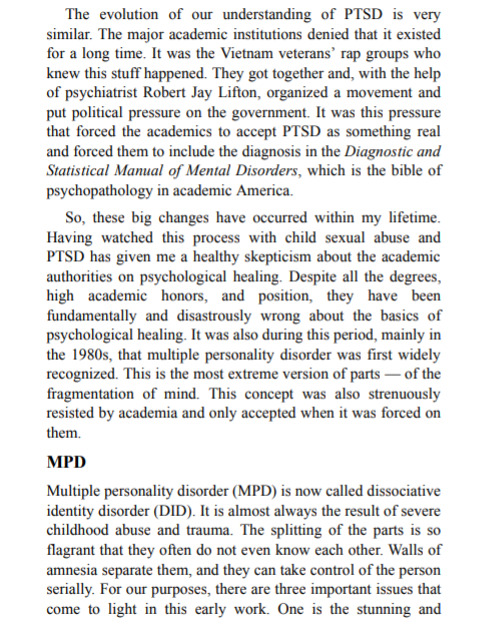
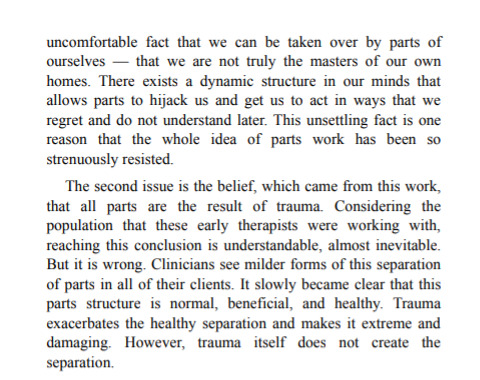
first of all, take note of his discussion of the contestation of even PTSD when they were trying to get it canonized in the DSM. an entire movement including political pressure had to be formed just to get ptsd into the literature. nowadays nobody on this website would (hopefully) contest the validity of ptsd as an experience people could have, but back then, people had to hold their ground against the psychiatric system and even the government just to prove that their experiences deserved to be taken seriously. don't think that this was the olden days either, because the academic world still tends to hold tight to its current state and not be welcoming towards experiences outside its own paradigms, so its good to keep in mind that there are histories and politics going into the making of all this psychological literature, with more room yet for even further and more uncommon experiences to be discussed.
second of all, note that he says that to clinicians working even with people with MPD/DID, it became apparent that the parts structure could be normal for people, beneficial, and even healthy, and that it was simply the severely dissociative aspects of it that they would work to heal, rather than viewing the entire experience of plurality as inherently disordered or solely a product of trauma.
i hope its clear by now that there's a lot of discussion surrounding this issue, but that plenty of it involves the normalization of nondisordered plurality, that plurality can be even healthy and a good, therapist-approved means of self-exploration for people, and that you should not cherry-pick literature while using intellectually dishonest argument techniques online.
endos are valid imho. i myself am a dissociative system, but at least i don't claim that my opinion is the standard opinion based on just that, i actually try to do my research. hopefully this was interesting to you, and please don't discourse on my post. kthxbai
#syscourse#dissociative identity disorder#did system#traumagenic system#endogenic system#actually multiple#original post
20 notes
·
View notes